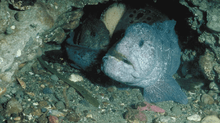Wolf eel
The wolf eel (Anarrhichthys ocellatus) is a species of wolffish (Anarhichadidae) from the North Pacific.[1] It is monotypic within the genus Anarrhichthys and one of only two genera in the family, the other being Anarhichas.[2]
| Wolf eel | |
|---|---|
_in_Puget_Sound_(6842178290).jpg) | |
| Wolf eel in Puget Sound | |
| Scientific classification | |
| Kingdom: | |
| Phylum: | |
| Class: | |
| Order: | |
| Family: | |
| Genus: | Anarrhichthys Ayres, 1855 |
| Species: | A. ocellatus |
| Binomial name | |
| Anarrhichthys ocellatus Ayres, 1855 | |
Description
A. ocellatus differs from true eels, as they have paired gill slits and pectoral fins. The animal can grow up to 2.4 m (7 ft 10 in) in length and 18.4 kg (41 lb) in weight.[1]
The young ones are orange with big dark spots in the posterior part of the body. Once older they turn grey, brown greyish or dark olive.[3][4]
They possess powerful jaws with which they smash their preys: canine teeth in the front and molars in the posterior portion of the mouth. In the anal fin it has no fishbones and 233 radius. It only has one dorsal fin, that extends from the head to the end of the body, with 228 to 250 flexible fishbones without soft radius. The caudal fin is small. No pelvic fins not lateral line. [5]
Males have large lips and a protuberance on the superior part of the head. The wolf eel usually lives for about 25 years.
Reproduction
They have a monogamous relationship and tend to mate for life and live in the same cave.
They reproduce from October until the end of winter starting from when they are around seven years old. The male puts his head against the female's abdomen and wrap around her, while she extrudes the eggs (she can lay up to 10,000 at a time) which he then fertilizes. Afterwards they coil around them and use her body to shape the eggs into a neat sphere roughly the size of a grapefruit, the male then coils around her to add an extra layer of protection. They both equally protect their eggs and only one at a time leaves the cave to feed.[1] The eggs will hatch after 91 to 112 days and during this period, in order to ensure correct circulation of water around the eggs to keep them supplied with oxygen, the female periodically massages and rotates them as they develop. [3][6][7]
Ecology
Distribution
A. ocellatus is found in caves, crevices and rocky reefs from shallow waters to a depth of 226 m (741 ft), ranging from the Sea of Japan and the Bering Sea to Northern California.[1]
Behavior
.jpg)

Large wolf eels are curious[8] and are rarely aggressive, but are capable of inflicting painful bites on humans.[1] The male and female may pair for life and inhabit a cave together; the two watch their eggs together and one always stays behind when the other leaves to feed.[1][4]
Diet
This eel-like fish feeds on invertebrates with hard shells (crustaceans, sea urchins, mussels, clams) and some fishes, crushing them with its strong jaws.[6][7] It has been observed in captivity that when they are fed soft food such as squid, they tend to prefer it over hard food, which can damage the back teeth.[3]
Predators
The adult's predators are sharks, big fish and harbor seals. [9] [10] The eggs and juveniles can be threatened by more species, since they are not that big and don't have yet the powerful jaws, many fish such as rockfish and kelp greenling will go after them.[3]
As food
The wolf eel has edible, sweet and savoury white flesh. In some coastal northwest Native American tribes, the wolf eel was referred to as the sacred "doctorfish". Only the tribal healers were allowed to eat this fish, as it was supposed to enhance their healing powers.[4]
References
- Froese, Rainer and Pauly, Daniel, eds. (2016). "Anarrhichthys ocellatus" in FishBase. November 2016 version.
- Froese, Rainer, and Daniel Pauly, eds. (2016). "Anarhichadidae" in FishBase. November 2016 version.
- "Wolf-eel, Reefs & Pilings, Fishes, Anarrhichthys ocellatus at the Monterey Bay Aquarium". www.montereybayaquarium.org. Retrieved 2019-11-26.
- Sempier, S. (2003). Wolf Eel at the Wayback Machine (archived July 20, 2011) Marine Species with Aquaculture Potential.
- "Wolf eel Anarrhichthys ocellatus".
- Coleman, R. M. (1999). Parental care in intertidal fishes. USA: Academic Press. pp. 165–180. ISBN 9780123560407.
- Love, M. (1996). Probably More Than You Want to Know About the Fishes of the Pacific Coast. California, USA: Really big press. ISBN 0962872555.
- http://www.oceanlink.info/biodiversity/wolfeel.html
- "National Aquarium | Wolf Eel". National Aquarium. Retrieved 2019-11-26.
- "Wolf-eel". Alaska Sealife Center. Retrieved 2019-11-27.
External links
| Wikimedia Commons has media related to Anarrhichthys ocellatus. |